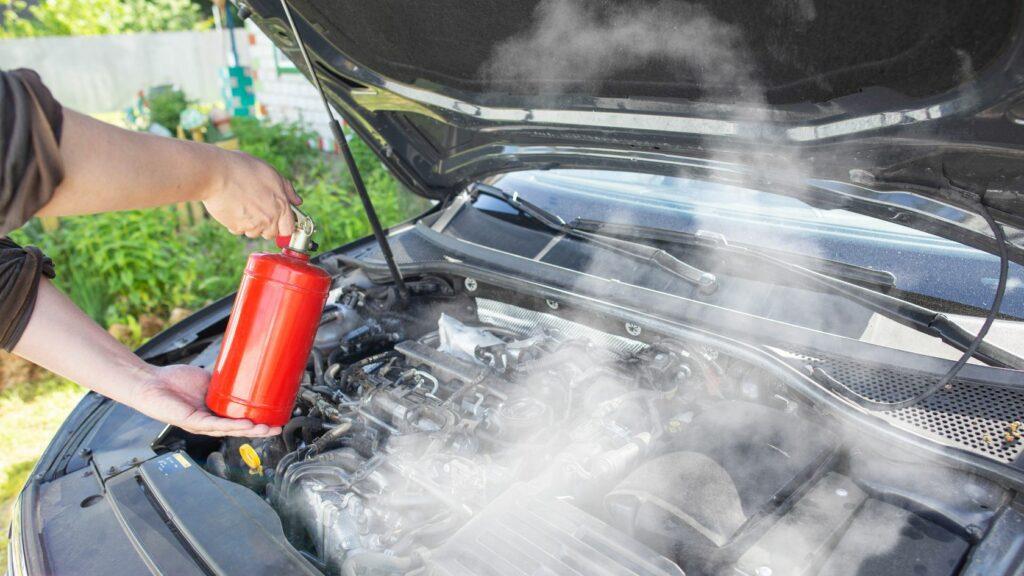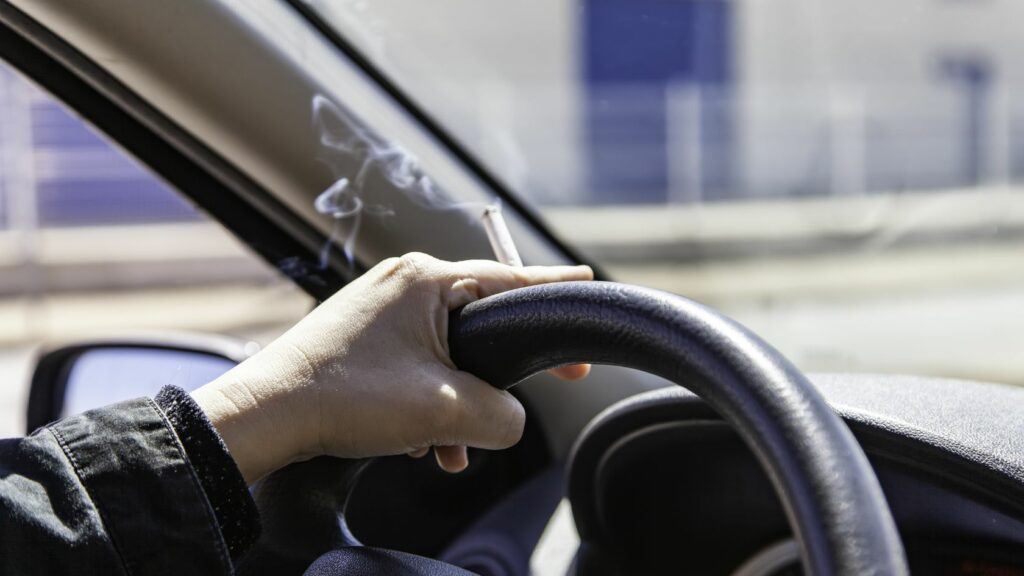
While driving a car is a routine activity for many motorists, it’s essential to remember that unexpected emergencies can occur. One such frightening scenario is a car fire while driving.
Although car fires are relatively rare, they can be extremely dangerous and require quick thinking and immediate action. So, what to do if your car catches fire while driving?
In this blog post, we will discuss the causes of car fires while driving, how to prevent them, and most importantly, what steps to take if your car catches fire while on the road.
What to Do if Your Car Catches Fire While Driving
When your car catches fire while driving, follow the below steps to remain safe from the dangers of fire:
Stay Calm – Most car fires are due to mechanical failures which are often controllable. Whenever you get a feeling that your car is going to catch fire while driving, the first and most crucial step is to stay calm. Panicking can cloud your judgment in this critical situation.
Signal and Pull Over – The next step is to slow down, put on a side signal, and pull your vehicle over to the side of the road, as far away from traffic as possible. Ensure to turn off the engine completely.
Evacuate Quickly – Once stopped, evacuate the vehicle swiftly. Ensure that all occupants get out and move to a safe distance quickly.
Once the car is vacant, close the doors without locking them completely. Put on the hazard lights, and if you have a hazard sign/triangle, place them around the car to alert the oncoming and passing traffic.
Do NOT Open the Hood – Many motorists try to open the hood of a car out of curiosity. This is really dangerous. Opening the hood can introduce oxygen and potentially make the fire worse.
If the fire has been spreading beneath the hood, it may flare up dangerously onto your face or body when you open the bonnet. To be on the safer side, leave it closed.
Use a Fire Extinguisher– While opening the hood is not recommended in firing circumstances however, if you have a fire extinguisher and are trained to use it, attempt to open the bonnet systematically to extinguish the fire.
Make sure to gear up appropriately before attempting to use a fire extinguisher and always keep your safety as the top priority while dousing the fire.

Call Emergency Services – If you do not want to risk using a fire extinguisher and dousing the fire yourself, dial emergency services immediately to report the fire.
Provide them with your location and a description of the situation. You must also notify the authorized service centers and insurance service providers to get additional help and insurance claims as necessary.
Till the help arrives, do not re-enter the vehicle or attempt to deal with the fire yourself if it’s out of control. It is better to wait for professional assistance.
Why Do Cars Catch Fire While Driving? Causes and Symptoms
It is important to learn and understand the causes and symptoms of car fire while driving to implement the above-mentioned steps. Here are a few causes and signs of car fires:
Mechanical Failures
One of the leading causes of car fires is mechanical failures. These can include issues with the engine, exhaust system, or fuel system.
For example engine overheating! While driving, you may notice the engine temperature gauge rising into the red zone. This is because there could be steam or coolant leaking from under the hood, and you might observe reduced engine power or unusual engine noises.
If the engine gets excessively hot, it can ignite surrounding materials, such as oil, or coolant leading to fire.
Similarly, the exhaust system can become damaged due to corrosion, rust, or impacts with road debris. Damaged exhaust components can expose hot gases or surfaces that may ignite nearby materials.
Loud exhaust noises, reduced engine performance, or noticeable damage to exhaust pipes are some of the symptoms of exhaust system damage.
Lastly, if you smell gasoline or a sudden drop in fuel efficiency these are the signs of fuel system issues.
A ruptured fuel line, malfunctioning fuel injector, or a faulty fuel pressure regulator can leak fuel onto hot engine components or exhaust parts leading to a fire.
Electrical Problems
Faulty wiring or electrical components can also trigger a car fire. One of the symptoms of electrical failures while driving is malfunctioning connections such as the radio or lights suddenly going out.
Overloaded circuits, damaged insulation, worn-out electrical components, or electrical shorts can generate sparks that ignite flammable materials inside the vehicle.
Brake System Failures
The braking system of a car also plays a crucial role in car fires. Brake system failures can occur due to overheating of brake pads, or a malfunctioning anti-lock braking system (ABS).
When the braking system fails, you will notice reduced braking effectiveness, hear grinding noises when applying the brakes, or notice a burning odor coming from the wheels.
Overheated brakes can ignite nearby components or fluids, leading to fire but before that braking system failure also means you won’t be able to stop your car appropriately which could result in accidents. Speaking of accidents, this is another major cause of concern for car fires.
During accidents, fuel leakage is quite common. When the fuel spills across heated car parts it can lead to a dangerous situation of car fire.
Transmission Problems
Similar to fuel leakage, a leaking transmission fluid line or a damaged torque converter can lead to fluid discharge.
When you notice problems while shifting gears, or the gear is slipping constantly it is an indication of transmission problem. The leakage of transmission fluids onto hot exhaust parts poses a risk of fire.
How to Prevent Car Fires
Now, that you know the causes and symptoms of car fires and how dangerous it could be while driving follow the below steps to prevent car fires:
Regular Maintenance – The best way to prevent car fires is by maintaining your vehicle properly. Regularly servicing your car, checking for leaks, monitoring the wear and tear, and addressing any mechanical issues in a timely manner can significantly reduce the risk of fire.
Avoid Overloading Electrical Systems – Don’t overload your vehicle’s electrical systems with aftermarket accessories or modifications as the process always involves amending the electrical wiring connection. If it is really necessary, ensure that all electrical work is done by a qualified professional.
Monitor the Exhaust System – Keep an eye on your car’s exhaust system for any signs of damage or rust. Replace damaged components promptly.
Safe Fueling Practices – Be cautious while refueling your vehicle. Avoid overfilling the tank, and if you suspect a fuel leak, seek immediate assistance. Always shut off the engine while refueling especially when the car components are really hot.
No Smoking Inside the Car – Smoking is injurious to your health as well as your car’s health. So, avoid smoking while you are driving as it may lead to serious fire in the event of sparks coming in contact with your car interiors.

Similarly, refrain from carrying explosive items or flammable substances inside the car. If the temperature gets really hot, it could ignite the flammable sources causing a bigger fire.
Keep a Fire Extinguisher – Always keep a fire extinguisher in your car. While doing so, ensure that you know the process of using a fire extinguisher correctly in firing situations.
More importantly, install the fire extinguisher at a place where it is easily accessible for prompt removal and action.
Park in a Safe Place – A car can also catch fire when it is parked. Take special care while parking the vehicle when you are back from a long drive.
Avoid parking in an area that is surrounded by risky materials or flammable items. During summer, prefer parking in a shaded section.
Car engines and other components remain hotter after long journeys and outside temperatures can make them more hotter leaving the vehicle vulnerable to fire.
Can You Continue Driving If The Car Shows Signs of Fire?
No, you should not continue driving if your car shows signs of fire. This is because driving a vehicle that is experiencing symptoms of fire can lead to dangerous situations.
There is a risk of fire escalating rapidly while driving especially if the fire is emanating from the car’s engine.
While the fire may not spread like it does when the car is idle, it may grow and become uncontrollable due to the surrounding parts. Moreover, you won’t be able to continue driving for a long time if the components such as electrical wiring are caught in fire.
Depending on the cause of the fire, there may be a risk of explosions. Given these risks, it is essential to prioritize safety and follow the previously outlined steps in this post.
Final thoughts
Experiencing a car fire while driving is a terrifying ordeal, but knowing how to react can make all the difference.
Regular maintenance, safe practices, and staying prepared are key to preventing car fires. In the event of a fire, quick thinking, and following the steps covered in this post can help ensure the safety of you and your passengers.
Always prioritize your safety and that of others on the road. Remember, a calm and collected response can save lives.


Hi, I I wouldn’t have ever thought about preparing for this but it makes sense. I remember being at a traffic light and seeing a garbage truck start on fire. Luckily the guy had a fire extinguisher. It just happened out of nowhere. Where I work, we also had a Zamboni start on fire. It does happen.
Hey Jake,
Thanks for sharing your thoughts!
Yes, car fires are rare but do happen. It is better to be well-prepared and take timely action of controlling the fire.